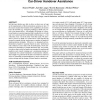Free Online Productivity Tools
i2Speak
i2Symbol
i2OCR
iTex2Img
iWeb2Print
iWeb2Shot
i2Type
iPdf2Split
iPdf2Merge
i2Bopomofo
i2Arabic
i2Style
i2Image
i2PDF
iLatex2Rtf
Sci2ools
AUTOMOTIVEUI
2015
ACM
2015
ACM
Autonomous driving: investigating the feasibility of car-driver handover assistance
Self-driving vehicles are able to drive on their own as long as the requirements of their autonomous systems are met. If the system reaches the boundary of its capabilities, the system has to de-escalate (e.g. emergency braking) or hand over control to the human driver. Accordingly, the design of a functional handover assistant requires that it enable drivers to both take over control and feel comfortable while doing so – even when they were “out of the loop” with other tasks. We introduce a process to hand over control from a full self-driving system to manual driving, and propose a number of handover implementation strategies. Moreover, we designed and implemented a handover assistant based on users’ preferences and conducted a user study with 30 participants, whose distraction was ensured by a realistic distractor task. Our evaluation shows that car-driver handovers prompted by multimodal (auditory and visual) warnings are a promising strategy to compensate for system bound...
| Added | 16 Apr 2016 |
| Updated | 16 Apr 2016 |
| Type | Journal |
| Year | 2015 |
| Where | AUTOMOTIVEUI |
| Authors | Marcel Walch, Kristin Lange, Martin Baumann, Michael Weber 0001 |
Comments (0)

